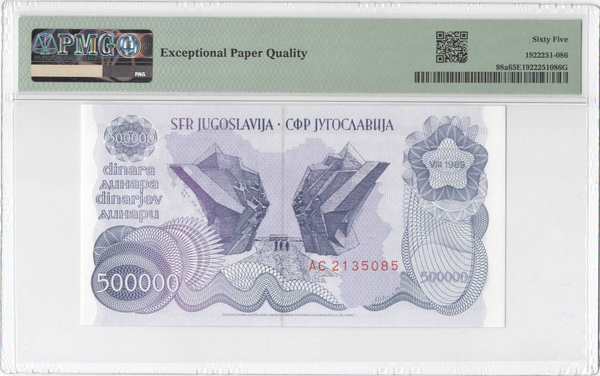-


1989 Yugoslavia 500,000 Dinars PMG 65 EPQ P-98a Gem Uncirculated Pre-Hyperinflation Note
Inc. TaxInc. TaxRRP: Inc. Tax$139.00RRP:1989 Yugoslavia 500,000 Dinars PMG 65 EPQ P-98a Gem Uncirculated Pre-Hyperinflation Note Offered here is a 1989 Yugoslavia 500,000 Dinars banknote, certified PMG 65 EPQ Gem Uncirculated, catalogued... -


1993 Yugoslavia 5,000,000,000 Dinars PMG 66 EPQ P-135a Gem Uncirculated Hyperinflation Note
Inc. TaxInc. TaxRRP: Inc. Tax$169.00RRP:1993 Yugoslavia 5,000,000,000 Dinars PMG 66 EPQ P-135a Gem Uncirculated Hyperinflation Note Offered here is an extraordinary 1993 Yugoslavia 5,000,000,000 (5 Billion) Dinars banknote, certified PMG... -


1993 Yugoslavia 500 Million Dinars PMG 67 EPQ P-134 Superb Gem Unc Hyperinflation Note
Inc. TaxInc. TaxRRP: Inc. Tax$142.00RRP:1993 Yugoslavia 500 Million Dinars PMG 67 EPQ P-134 Superb Gem Unc Hyperinflation Note Presented here is a 1993 Yugoslavia 500,000,000 (500 Million) Dinars banknote, graded PMG 67 EPQ Superb Gem... -


2008 Zimbabwe 50 Trillion Dollars PMG 66 GEM UNC P-90 Hyperinflation Banknote
Inc. TaxInc. TaxRRP: Inc. Tax$159.00RRP:2008 Zimbabwe 50 Trillion Dollars PMG 66 GEM UNC P-90 Hyperinflation Banknote Description: The 2008 Zimbabwe 50 Trillion Dollars banknote, cataloged as P-90 and graded PMG 66 GEM UNC (Uncirculated),... -


1993 Yugoslavia 500 Billion Dinara PMG 66 EPQ P-137a Planet Banknote Pedigree
Inc. TaxInc. TaxRRP: Inc. Tax$199.00RRP:1993 Yugoslavia 500 Billion Dinara PMG 66 EPQ P-137a Planet Banknote Pedigree Description: The 1993 Yugoslavia 500 Billion Dinara banknote, cataloged as P-137a and graded PMG 66 EPQ (Exceptional...
Description
1989 Yugoslavia 500,000 Dinara P-98a PMG 66 Gem Unc Hyperinflation Collectible
The 1989 Yugoslavia 500,000 Dinara banknote, cataloged as P-98a and graded PMG 66 Gem Unc, is an emblematic piece from a time of severe economic turmoil, marked by hyperinflation. This high-grade note reflects both the economic challenges and the artistic endeavors of Yugoslavia during this turbulent period.
Design and Features: This note features elaborate graphic designs that include prominent Yugoslav cultural and historical symbols. The front likely displays a significant figure or a national monument, symbolizing the enduring spirit of Yugoslavia amidst economic difficulties. The reverse may showcase an industrial or natural scene, emphasizing the country's attempts to showcase stability and progress. The PMG 66 Gem Unc grade indicates that this note is in exceptional condition, maintaining its original luster, vibrant colors, and detailed embossing, which are crucial for such high-denomination notes produced in rapid succession during hyperinflation.
Historical Significance: Issued in 1989, just before the disintegration of Yugoslavia, this 500,000 Dinara note is a stark reminder of the hyperinflation that plagued the country, leading to economic destabilization. It serves as a historical document that illustrates the dire economic conditions and the government's efforts to manage the crisis through currency issuance.
Collector's Value: Given its high grade of PMG 66 Gem Unc and its representation of a critical historical period, this note is highly prized among collectors. It offers insights into the socio-economic challenges faced by Yugoslavia in the late 1980s and is a poignant addition to collections focused on hyperinflation currencies or the complex history of the Balkans.




